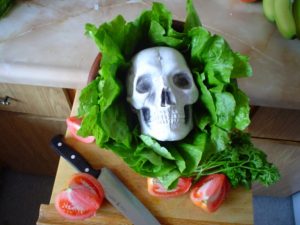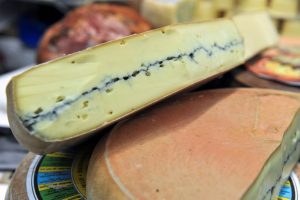It’s time to end the leafy greens cone of silence.

Top view of romaine lettuce that has been sliced on a wood cutting board.
This time it has made people unnecessarily sick.
I wouldn’t touch their product.
But how would I know?
On Sept. 14, 2006, the U.S. Food and Drug Administration announced that an outbreak of E. coli O157: H7 had killed a 77-year-old woman and sickened 49 others. The FDA learned from the Centers for Disease Control and Wisconsin health officials that the outbreak may have been linked to the consumption of produce and identified bagged fresh spinach as a possible cause.
Eventually, four would die and at least 200 sickened.
One of the responses was to form the Leafy Greens Marketing Agreement (LGMA) which apparently overseas most of the leafy greens production in the U.S.
They are known primarily for self-aggrandizing press releases.
And lots of rumors about how they inhibit epidemiological investigations into outbreaks of foodborne illness linked to their products (search ‘cone of silence’ on barfblog.com for plenty of examples)
According to the U.S. Centers for Disease Control, since the last update on April 10, 2018, 18 more people from 9 states were added to this outbreak.
How many of those could have been prevented if CDC or State health types fingered chopped Romaine lettuce when rumors started circulating? Is the goal of LGMA really to forego epi and demand absolute proof before going public?
As of April 12, 2018, 35 people infected with the outbreak strain of E. coli O157:H7 have been reported from 11 states. Illnesses started on dates ranging from March 22, 2018 to March 31, 2018. Ill people range in age from 12 to 84 years, with a median age of 29. Sixty-nine percent of ill people are female. Twenty-two ill people have been hospitalized, including three people who developed hemolytic uremic syndrome, a type of kidney failure. No deaths have been reported.
 Illnesses that occurred after March 27, 2018, might not yet be reported due to the time it takes between when a person becomes ill with E. coli and when the illness is reported. This takes an average of two to three weeks.
Illnesses that occurred after March 27, 2018, might not yet be reported due to the time it takes between when a person becomes ill with E. coli and when the illness is reported. This takes an average of two to three weeks.
Epidemiologic evidence collected to date indicates that chopped romaine lettuce is the likely source of this outbreak. Twenty-six (93%) of 28 people interviewed reported consuming romaine lettuce in the week before their illness started. This percentage is significantly higher than results from a survey[787 KB] of healthy people in which 46% reported eating romaine lettuce in the week before they were interviewed. Most people reported eating a salad at a restaurant, and romaine lettuce was the only common ingredient identified among the salads eaten. The restaurants reported using bagged, chopped romaine lettuce to make salads. At this time, ill people are not reporting whole heads or hearts of romaine.
 Traceback investigations are ongoing to determine the source of chopped romaine lettuce supplied to restaurant locations where ill people ate. At this time, no common grower, supplier, distributor, or brand has been identified. However, preliminary information indicates that the chopped romaine lettuce was from the Yuma, Arizona growing region.
Traceback investigations are ongoing to determine the source of chopped romaine lettuce supplied to restaurant locations where ill people ate. At this time, no common grower, supplier, distributor, or brand has been identified. However, preliminary information indicates that the chopped romaine lettuce was from the Yuma, Arizona growing region.
Information collected to date indicates that chopped romaine lettuce from the Yuma, Arizona growing region could be contaminated with E. coli O157:H7 and could make people sick.
Advice to Restaurants and Retailers:
- Restaurants and retailers should not serve or sell any chopped romaine lettuce, including salads and salad mixes containing chopped romaine lettuce, from the Yuma, Arizona growing region.
- Restaurants and retailers should ask their suppliers about the source of their chopped romaine lettuce.
That’s right, consumers, it’s up to you.
It should be up to the restaurant or retailer, who markets food safety at point-of-purchase.
And LGMA, which covers Yuma growing, should be forthcoming about risks, rather than blowing themselves in nonsensical tweets.
 As John Prine famously sang, all the news just repeats itself.
As John Prine famously sang, all the news just repeats itself.











 Don and Ben then edible cookie dough validation (or lack thereof), sour milk pancakes and backyard chicken eggs. The episode ends on a discussion of moldy, fermented rice used as a meat flavor enhancer, glitter beer and Listeria in frozen corn.
Don and Ben then edible cookie dough validation (or lack thereof), sour milk pancakes and backyard chicken eggs. The episode ends on a discussion of moldy, fermented rice used as a meat flavor enhancer, glitter beer and Listeria in frozen corn.